Student and Staff Perceptions of Decision-making in the changing Higher Education Context
Zoe Baker[1], Faculty of Development and Society, Sheffield Hallam University
Abstract
Since the introduction of fees for higher education (HE) in 1998, there has been significant research carried out exploring the perceptions of, and choice available to, potential students regarding progressing to this level of study (Archer, 2000; Archer and Hutchings, 2001; Reay, 2001; Ball et al., 2005). Recently there has been a substantial change in the political landscape of HE following the introduction of the White Paper: "Students at the Heart of the System" (Department for Business Innovation and Skills, 2011). As yet, there has been little attention given to potential applicants' perceptions of accessing HE in this changed context. This article begins to address this gap in knowledge through an investigation of further education students' perceived futures. The study also contains an exploration of perceptions of staff who work within a post-1992 university team who aim to widen participation by providing information and guidance about HE to local schools and colleges. This aspect of the research considers the views of these staff regarding the impact that the proposed changes may have on student choice, as well as on their work. By addressing both student and staff perspectives, this can provide an insight into the impacts of the White paper.
Keywords: Higher Education, Student recruitment, White Paper, Post-16, Fees, Widening Participation
Introduction
A substantial amount of research has been carried out exploring the perceptions of, and choice available to, potential students regarding progressing to HE following the introduction of fees for higher education (HE) by New Labour, and the emergence of variable tuition fees in 2003 (Alley and Smith, 2004; Archer, 2000; Archer and Hutchings, 2000; Archer and Hutchings, 2001; Ball et al., 2002; Ball et al., 2005; Callender and Jackson, 2005; Christie and Munro, 2003; Morrison 2008; Reay, 1998; Reay, 2001). This research explores the decision-making discourses of post-16 students in relation to characteristics such as social class, ethnicity and debt aversion, as well as applying theoretical analysis to the decision-making process.
From September 2012, the cap on undergraduate tuition fees will rise from £3000 to £9000 per year in the majority of HE institutions as proposed in the recent White Paper "Students at the Heart of the System" (Department for Business Innovation and Skills (BIS), 2011). This marks a significant increase in the contribution required from the student. The legislation not only outlines proposals which significantly alter not only the structure of funding, but also admissions and marketing in the HE sector in order to place students "at the heart of the system" (BIS, 2011a). The intention is to provide potential applicants with more choice and value for money regarding their HE choices. It hopes to accomplish this by making it an obligation for universities to provide Key Information Sets (KIS) (see Appendix 1). These include statistics on a range of areas such as graduate employment rates, earning potential, teaching hours and accommodation costs (BBC News, 2011; Channel 4 News, 2011; Paton, 2011; Scott, 2011; University Business, 2011; Vasagar, 2011a; Vasagar, 2011b). Alterations in admissions quotas have also been planned, allowing "unrestrained recruitment" of students achieving AAB grades (BIS, 2011b), and placing a cap for those applying to institutions charging less than £7000 (Scott, 2011). These proposals accompanying the increase in fees contribute to the re-conceptualisation of the role of the HE institute as a market-oriented 'service provider', in which students become positioned as consumers (Molesworth et al., 2010). Despite studies being carried out on student perceptions regarding HE progression previously (Archer, 2000; Archer and Hutchings, 2001; Archer et al., 2003; Ball et al., 2002; Reay, 1998; Reay, 2001) the influence on how potential applicants perceive accessing HE in this changed context has had little consideration. This is also true in the case of staff who work within student recruitment whose aims to widen participation and their roles generally may be affected by the proposals.
Research Purpose, Focus and Aims
The purpose of this research was to discover the perceptions of HE of post-16 students and staff working in student recruitment due to the changes occurring following the release of the "Students at the Heart of the System" White paper (BIS, 2011). More specifically, I hoped to investigate what factors were influential in students' decision to attend HE, or what acted as a deterrent to applying. In cases where students did intend to progress to HE, I intended to uncover what aspects aided them in their decisions to choose particular institutions. I expected that this would provide an insight into how the White Paper could affect student decision and choice, yet it is important to note here that we cannot be sure that it is the White Paper that has solely affected their decision.
As student perceptions are a large focus here, I felt it would also be useful also to investigate the perceptions of staff working in student recruitment. The motivation for this was not solely because these had not been addressed in the contemporary context but was also due to:
-
Their close work with the recruitment of students and their obligations to fair access;
-
The research would be useful in their line of work, particularly in respect to the development of future recruitment objectives as it may provide a clearer understanding into how students perceive HE;
-
By investigating recruitment team staff as well as student perceptions, it may provide a more comprehensive overview of the effects of the White Paper.
Therefore, although there is a large emphasis on student perceptions as there has been little research into this in response to the changes in HE, the student recruitment team's views are just as significant. The team used in the sample closely liaise with marketing and admissions, and as the proposals may impact all of these teams' work to some degree it would be noteworthy to examine these. This also provides an opportunity to view and analyse the differences and similarities between both student and staff samples if any.
Method
Student perceptions
A local sixth form in an 11-18 age-range institution was used to access the student sample. The school was new, only having been built in the year prior to this research with its first students enrolling in September 2011. This was built to replace two local secondary comprehensive schools which the local council had made a decision to close in 2007. Due to the school opening just 6 months before data collection took place, it would have been problematic to assign the institution a socio economic status. The students who attend the school are from a range of areas due to the varied catchment areas of the original two institutions. The last Ofsted report published for one of the schools states in the description that students "come from an economically mixed catchment area" (Barnett, 2009: 3). The other school's report also notes that "students live in areas of the city which are less advantaged than is typical nationally. A significant number travel from more distant neighbourhoods ... it has a very dispersed catchment area" (Muir, 2009: 3). The school therefore had a mixed demographic.
Two focus group meetings in which a semi structured interview method was incorporated were conducted in this institution in order to investigate student perceptions. These lasted around 30 minutes each. Every member of this sample were currently in year 12 as a voluntary sampling method was used in order to prevent any interference with the student samples' timetable. As a result, only year 12 students were available to take part at the time of data collection, whereas a mix of year 12 and 13 students would have been more desirable for the research intentions By only being able to access year 12s this meant that none had formally entered the application process for HE, potentially infringing on the aim of assessing influential factors regarding choice of university. Nevertheless, choice of whether to attend HE was still able to be investigated. Due to this, valuable insights into student choice emerged mainly regarding the initial decision on whether or not to access HE which will be appraised later on. Before the main discussion took place, pseudonyms for the students were established and each participant completed a poster activity in which they described their perceived futures in association with different time scales (see Appendix 2). Questions were then asked in relation to the participant's posters, particularly focusing on HE or other plans that the students had considered.
As the research progressed, it became apparent that concerns were present in the media over the effects that certain proposals would have on non-traditional students. The reallocation of places and the competition caused by this as well as the potential that the fees increase has in deterring students raised anxieties over widening participation (NUS.org, 2011; Vasagar and Williams, 2010).The perceived impacts of these proposals was the emergence of a "two-tier" admissions system as a result of the proposed introduction of "unrestrained recruitment" of AAB students and the cap placed on institutions charging £7000 or less (BBC News, 2011; Scott, 2011; Swain, 2011a; This is Money, 2011; Vasagar, 2011b; Vasagar et al., 2011). Apprehensions existed that this could create a divide in which non-traditional students would be drawn to a "lower-cost model" of education (Seaton, 2011; Vasagar, 2011b).
For this reason I wanted to ensure that a post-16 institution was used in order to increase the chance of acquiring a sample which would be deemed as non-traditional students. This could not be ensured by my sampling method as a voluntary rather than a selected sample was used so as to not impede on the schedules of the institution. Yet the institution contained a mixed demographic of class backgrounds due to the way in which this was formed as noted earlier. This aided in fulfilling this requirement to an extent.
Staff perceptions
This aspect of the research was carried out in a team within a post-1992 university (the Student Recruitment team). The team offers information to local partnership schools and colleges regarding HE, with the aim of increasing and widening participation. The university is situated in an area of South Yorkshire where in some wards disparities exist in HE participation (Kay and Walker, 2006). In response to this, recommendations were made to widen participation prompting universities "to consider how they can facilitate a coherent and sustainable presence in low participation neighbourhoods" (2006: 6). The team was developed in 2005, and its work responds to these recommendations.
I conducted five semi-structured interviews with individual staff members who worked within the team, each lasting 20 minutes. Staff who worked in differing roles were interviewed, which allowed a useful range of perspectives to be gathered. The interviews contained questions based on the following themes:
- Perceived immediate and long term effects of the White Paper proposals;
- Marketing;
- application numbers;
- recruitment activity.
The semi-structured interviews provided the opportunity for me to ask additional questions, and to evaluate the answers provided as well as to focus on the key themes I wanted to address (Cousin, 2009; Grix, 2010; Klenke, 2008; Lodico et al.,2010; Mitchell and Jolley, 2010).
Findings
Consumer culture
A recurrent theme in the staff responses was the effects of the introduction of the Key Information Sets (KIS). It was suggested that by offering the same statistical data for each course, it may result in university choice being similar to comparing a product online:
I suppose where universities will get a bit worried or marketing teams will get a bit worried, is the idea that you will be essentially providing information in a 'compare the market.com' kind of sense.
(Staff 1)
Although this shows clearly how HE choice is moving to a more "market culture" (Staff 2) with students positioned as consumers (Molesworth et al., 2010), this was not perceived as negative by staff. This was primarily due to the reason that it is providing students with more information and the ability to make "more informed choices" (Senior staff 1) about their HE options. Yet a danger of this was stated to be the reduction of university choice to statistics:
I think that marketing teams will have their work cut out because they have an obligation to provide this information, but at the same time trying not to lose that feel of what the university is, and what is brilliant about it that you can't put down just on a list of statistics.
(Staff 1)
Therefore, although the KIS are viewed as positively aiding student choice, there are concerns over institutions being reduced to statistical data and the potential neglect over their unique features which could be problematic for university marketing teams. Stemming from this, concern existed as to whether this may lead to a heightened consumer culture in which potential students will use the KIS to assess which course will give them the "biggest return on their investment" (Staff 1). There existed speculation that HE choices may be assessed on the likelihood of graduate employment, rather than other benefits of HE:
It's whether or not students take on that consumer culture and look at it based on this list of information, this list of statistics. Or if students continue to view, going to an open day, getting a feel to the place you know ...rather than 'is it simply going to give me a job at the end of it that's going to give me enough money so that I can pay my loans back?'
(Staff 1)
Other important concerns arose that education may be perceived as an economically fuelled investment by potential applicants, perpetuated by the university's obligation to produce KISs. One staff member notably questioned whether this would reduce the perceived benefits of HE to "economic value" (Staff 2), neglecting other important aspects which are beneficial to society:
I think in changing education to a commodity and giving it central kind of focus like economic value I think you lose out on the other stuff which is that education is also a value to society ...I can tell you employability is an emerging theme...it does really show the damage that perhaps the changes are making as well. When we start looking into it at a deeper level, it's changing the nature of education.
(Staff 2)
By referring to "employability" while discussing the changes of how HE may begin to be perceived through the lens of "economic value" following the White Paper, this draws an important link between the employability agenda and choice. This was present in the student data; overall, the student participants displayed a large focus on employment.
As stated previously, the students were asked to complete a poster template of their perceived futures (Appendix 2). In order to establish the most frequently occurring information within these, I used a web-based programme (Feinberg, 2011). This provides a visual representation of inputted text, with the most frequently entered word displayed in a larger size (Figure 1). "Job" is shown to be the most commonly mentioned word with "time", "working" and "university" as the following most recurrently occurring.

Figure 1: Student responses to their perceived futures (poster activity)
Not only could this raise a link between the current context and student choice within the sample, it also raises significant insights into the HE decision making process. Ball et al. (2005) incorporate and apply Du-Bois Reymond et al's (1994: 4) "normal" and "choice" biography to HE decision making. According to Ball et al's (2005) interpretation, non-traditional students often follow the characteristics of choice biography, weighing up the cost and benefits of a university education in which potential economic rewards may be viewed as a justification for the cost. Traditional students (often from middle-class backgrounds) were believed to not enter any distinct decision-making process; their progression to HE is taken for granted (Archer and Hutchings, 2000; Archer and Hutchings, 2001; Ball et al., 2005; Christie and Munro, 2003). With the increasing focus on employability in the current HE context coupled with the rise in student financial contribution, it may result in this being perceived as a dominant benefit in students' choices to apply. Staff perceptions complied with this notion. They believed student choice would be informed significantly by the clarity of a career route that a course offers:
Are they going to continue to view higher education in the way that most students do now, which is based on 'what do I want to do?'...As opposed to well 'I might be really interested in a liberal arts course but is that going to give me sufficient money to pay back all of these loans? Oh I best do business or law'
(Staff 1)
The minority of students in my sample who had already begun to consider HE were attracted to courses with strong vocational elements, and thus those with an obvious link to employment. Nursing, child care and teaching were mentioned by those who were in the very early stages of considering attending HE.
Debt perception: "An occupational hazard"
Staff often speculated how they thought students may perceive the increased costs of HE, not just in relation to choice but in general:
As an 18 year old ... I might think that 'higher is just a rip off you know they're charging nine thousand and what are you getting for that?'
(Staff 3)
They knew that the fees were going up, they knew that they were going to take out student loans to live off... the current system has been in place for long enough that they see that as an occupational hazard of being a student.
(Staff 1)
It is apparent from the above quotations that staff tried to understand how potential applicants may view debt from trying to place themselves in the shoes of the student, and from their own perceptions such as the financial demands of HE being the norm due to its establishment for such a long period of time. Other interview data also drew on anecdotal evidence of the demand for information on finance not being as great as they expected, leading to the assumption that the fee increase may not be a huge deterrent:
What we did is really focus on the finance provision... and sort of clear up any misguided ideas they had... we've found that people don't have those sort of questions which has been surprising.
(Staff 2)
The student sample did not raise the financial costs of HE explicitly, but the minority who were considering applying wanted to remain at home to save costs or continue with part time employment:
I've been looking at Sheffield so I can keep my job.
(Claire)
I want to stay in Sheffield...it's just easier. You don't have to pay anything.
(Jake)
This echoes similarities of the notion of "working-class localism" in which Reay (2001: 861) suggested that for working-class students: "Material constraints of travel and finance often mean they are operating within very limited spaces of choice". As shown in Claire and Jake's comments, the choice to stay local was influenced by the accessibility to current employment, and minimising costs by remaining in the parental home.
The importance of providing clear and accurate "information, advice and guidance" (Senior staff 1) to partnership institutions and the students, parents and teachers associated with these was a central theme. Again, information regarding finance was focused on here in the aim to rectify or prevent "misguided ideas" (Staff 2) and they planned to provide "context" (Senior staff 1) to the increase in fees by focusing on the benefits of HE in their delivery of information:
We really had to think about our messages ...making people realise the benefits of higher education, but putting that in the context of having to pay those fees.
(Senior staff 1)
In addition to informing potential students of the advantages of HE in order to put the increased fees into context, a noteworthy point by one staff member was raised. This was concerning how a shift in perceptions of student loans from debt to a "graduate tax" (Senior staff 1) may alter attitudes towards the student finance system:
I think the media put a lot of hype on what's going on and really panic people and think about these gross debts and actually if they saw it more like a sort of graduate tax, they might see things in a little bit of a different light.
(Senior Staff 1)
Despite previous research being carried out into how current or potential students view debt (Archer et al., 2003; Ball et al.,2002; Ball et al.,2005; Christie and Munro, 2003), little has been done to investigate how graduates perceive the repayment of their student loans. It may be useful to consider this to see if graduates do conceive this as a "graduate tax", or as the repayment of debt. This could be valuable in contributing to information provision by the student recruitment team to provide potential applicants with an insight into this to aid their decision making about entering HE.
It is clear from staff views that there is a difficulty in trying to establish how students view the finance system in the context of the recent changes. In an attempt to form an understanding staff tended to attempt to draw conclusions from their own experiences and opinions. Yet many staff members remarked that they were unsure of what the impacts of the increased cost of HE would be. In response to this, the team were adopting measures such as providing clear, factual information and a more "reactive" rather than "prescriptive" approach (Staff 3) to cater for any increased demand or confusion predominantly regarding finance.
The next generation
Focus for recruitment activity was noted by the student recruitment team to be increasingly important for those students currently in years 10, 11 and younger. There was apprehension that this cohort of students would be affected more acutely by the White Paper's proposals. Those students currently in year 12 and 13 were perceived as already being on the "decision-making journey" towards HE:
Year 12s, I think institutions will be fine in 2013...they are well on their decision making journey to come to university.
(Staff 1)
The year 12s at the moment and the year 13s have already started on that journey, and have already committed to that ...I think it's going to be year 11s specifically.
(Staff 4)
However, the student data contradicted this: many of the students involved in the focus groups were undecided about progressing to university. One student also commented that not much information had been provided to them as of yet, but that this was not desired as they wanted to focus on their current studies before considering future options:
We haven't had that much information on it at the moment, you get more in the second year...I'd prefer to concentrate on my AS levels first.
(Claire)
It was acknowledged by a senior staff member that gaps in information provision did exist between institutions and that they intended to "plug" this gap (Senior staff 1). It may be worth considering that some students may not desire information as it could be perceived as overwhelming at this stage. Yet, as stated earlier, the staff members interviewed spoke of a reactive approach now being implemented in the provision of information. This will therefore ensure that the team are confident that the information they are providing will be useful to specific institutions. It is also important to note that the institution accessed for the student data collection had only recently been built, providing an adequate reason as to why this had not yet been visited by the student recruitment team at the time of data collection.
Uni, job or experience?
When focusing more specifically on students' perceptions of their futures, it was evident from the "year 2" milestone in the poster data that the majority of the sample were undecided between attending university or accessing employment (See Appendix 3). Some students even suggested that they intended to gain experience after post-16 education before considering progression to HE:
Second year, try to get a part-time job with a coaching company to gain more experience...Then for 5 years start working full time with a sports company, and maybe go to uni.
(Paul)
In two years maybe thinking about university or having experience and in 5 years hopefully I'll have some experience in childcare.
(Lorna)
The intention to gain experience in their chosen field seems to be described as a higher priority than entering HE straight away by these students. Paul prioritises working in his field before moving onto university, and Lorna mentions "university or having experience" in two years' time, appearing to weigh these options with equal value.
When students' answers were discussed further, some students arrived at the conclusion that attending university may be a safer option than attempting to enter the world of work due to there being a lack of employment options available:
I sort of thought well, see what it's like when it comes to the time of going to university, because if there is still no jobs around then there's not much possibility that I'm actually getting a job. It's probably best that I go to university, and then at least you're doing something instead of sat around doing nothing with your life.
(John)
It appeared that John was still not fully decided about attending university, claiming that he will "see what it's like" when he comes to the end of his post-16 education. Here, university seems to be viewed as an available option, and more favourable as opposed to the perceived uncertainty of the current employment market. This can contradict previous research findings which examine student perceptions of accessing HE. Archer (2000) suggested that potential applicants were reluctant to enter HE as a degree may not dramatically enhance their employment prospects due to the increased competition in the graduate employment market. Therefore, HE in Archer's (2000) research was not regarded as a safe option, but one characterised by risk. Yet this research was carried out over a decade ago, and it needs to be considered that the difference in perceptions of entering HE may be related to different economic trends which impact on the availability of employment.
In 2008, our economy entered a recession for the first time since 1991 (BBC News, 2009). Thus at the time of Archer's (2000) research, the economic climate was much different. According to Parliament.co.uk (2012) "recessions can have a stronger effect on the employment of young people than others"; the writer suggested that this was a consequence of employers potentially reducing or even ceasing recruitment, and a preference for retaining employees with more experience, placing younger workers at a disadvantage (Parliament.co.uk, 2012). The way in which John states "if there is still no jobs around" conveys an awareness amongst post-16 students of the current economic climate, and the differences in how HE may be viewed could be associated with this.
The ambiguity of the future conveyed in many of the students' comments demonstrates a relationship to 'choice biography' (Du-Bois Reymond et al., 1994). Ball et al. (2002: 57) suggest that students whose choice making processes comply with this notion display their future as: "unimagined or highly generic – 'a good job'". This is also emphasised by the student sample's perceptions of their futures in 10 years (see Appendix 4), in which "job", "house" and "family" are frequently mentioned. Despite the majority of students having not arrived at a certain decision to enter HE – in contrast to the staff perception, which was that such a decision had already been made – one staff member suggested that universities will still maintain application numbers due to a lack of alternatives: "there are not loads of jobs out there for that age group of people, not many lovely apprenticeship schemes out there" (Staff 1). This idea alongside the concern over the next generation of applicants (typically 2014 and 2015 entry) could result in a change in application patterns and options available to school leavers in the future. HE may no longer be regarded as a safe option in favour of employment or apprenticeship schemes. Yet, the student recruitment team reported that they are focusing resources on younger age groups to ensure that potential applicants are knowledgeable about accessing HE in order for them to make an informed decision. This approach will hopefully continue to widen participation, rather than HE be ruled out of these young people's futures in favour of potentially emerging alternatives due to the cost being perceived as too great.
Conclusion
Staff and student perspectives in the landscape of the changing HE context have offered some valuable insights into the impacts, or rather the perceived impacts, of the "Students at the Heart of the System" White Paper's proposals (BIS, 2011). Themes which were significant were staff perceptions of the possible emergence of a consumer culture surrounding HE choice, speculation over the effects of the fees increase, and thoughts regarding how debt may be perceived by students. Staff also collectively explained how they were trying to minimise any possible negative impacts of the proposals by providing additional finance information, adopting a reactive approach to information provision, and citing the importance of providing clear and factual information.
Although specific influential factors when considering applying for HE institutions did not extensively emerge amongst the student sample, other important considerations were raised. One of these which clearly contrasted with staff perceptions was the way in which the year 12 students seemed undecided about their futures and if HE held a place in them. Staff had mentioned that they perceived that those students currently in post-16 education had already started on the HE decision-making journey. It was felt that the White Paper's proposals would have a more substantial impact on those currently arriving at the end of their compulsory education. This may be useful to consider, as it could provide a valuable insight for the student recruitment team to ensure that resources tailored to year-12 students are maintained.
Despite the fact that they were currently studying post-compulsory academic courses, the student sample demonstrated a focus on vocationally orientated courses in HE. This complied with some staff perceptions which suggest students may be more intent on accessing these for employability benefits. Students appear to be drawn to these courses due to their clear employment routes and staff felt that this may be due to these possibly being viewed as having an increased potential to provide a "return on their investment" (Staff 1). Previous research has suggested that traditional students do not enter the cost/benefit considerations with regard to HE participation, but rather it is taken for granted (Ball et al., 2002; Christie and Munro, 2003). As a result of this, the clear link between a specific degree and employment may not be considered, as the same risks that non-traditional students contemplate are often not present for these students to consider the likelihood of a 'return' on their university education. Thus, it may be that traditional students continue to apply for pre-1992 universities as the course-employment link is not of vital importance for them to feel obliged to opt for a vocationally orientated course. When considering this, the conjectures highlighted in the media of a "two tier system" (Vasagar, 2011b) occurring may be conceivable.
Findings that emerged from the staff sample concerning debt perception can provide important implications for research investigating this to be carried out. Some evidence indicated that staff were uncertain of how potential applicants may perceive debt. Although research has been done previously into post-16 students, and current HE students perceptions of debt (Archer et al., 2003; Ball et al., 2002; Ball et al., 2005; Christie and Munro, 2003), it would be valuable to carry this out in the changed context. It may also be useful if graduate views on paying back their student loans could be established through further research. This could be beneficial to student recruitment teams in general, as it may provide informative evidence to use in information provision to aid potential applicants in making more informed choices about entering HE.
A noteworthy point made by one staff member was that people will continue to access HE as there are not many alternatives present for school leavers. This emerged from some student narratives, where students suggested that entering HE would provide them with more certainty than entering an ambiguous employment market. It would be interesting to see if more alternatives develop for this age group in the future, and if staff perceptions of the future of HE are accurate. This emphasises the importance of research to be carried out over the following years regarding HE; not just concerning perceptions, but also any changes in application numbers, course choice and options available to those leaving compulsory education.
Acknowledgments
I would like to thank the student recruitment team for contributing to the research and also the sixth-form students who kindly shared their thoughts and perceptions. A special thank you to my academic tutor Tamsin Bowers-Brown. I have been incredibly lucky to receive your invaluable help and support over the course of my degree.
List of Figures
Figure 1: Student responses to their perceived futures (poster activity).
Appendices
Appendix 1
An example of a Key Information Set (KIS) (Source: HEFC, 2011. Reproduced with kind permission. Please note: this is a mock-up and the text and elements of the design may change)
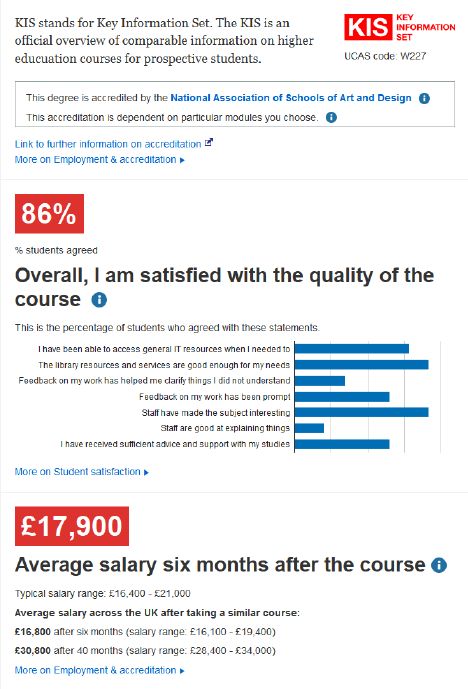
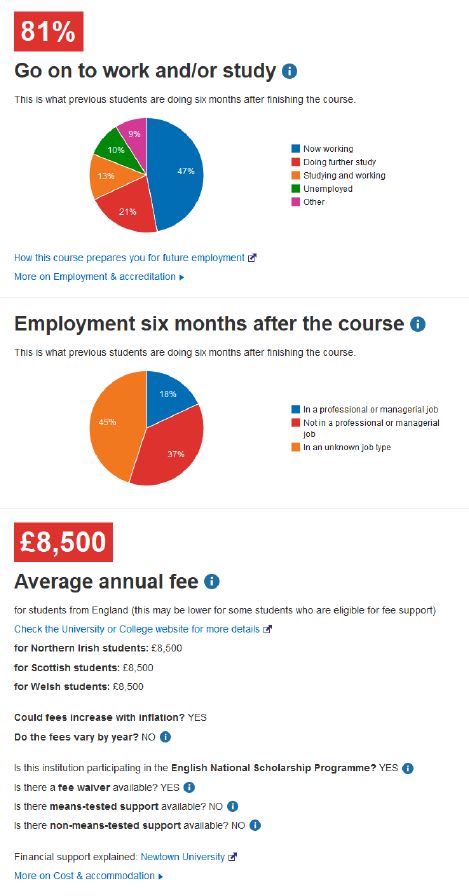
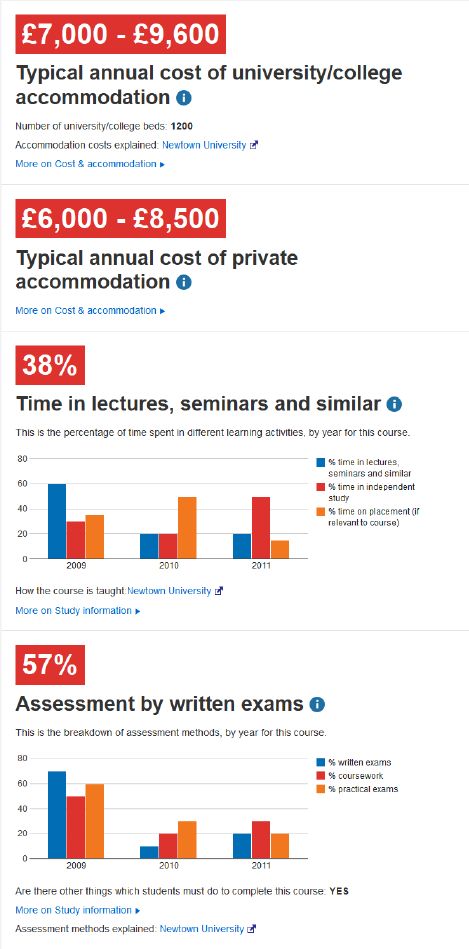
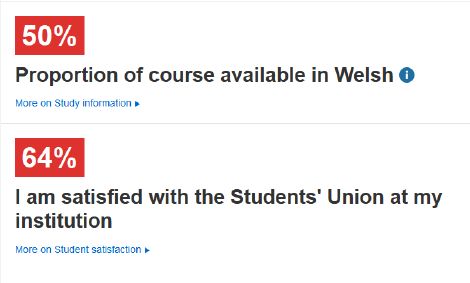
Appendix 2
Student poster template (Source: from the author's own collection)

Appendix 3
Focus group poster data two years (Source: from the author's own collection)

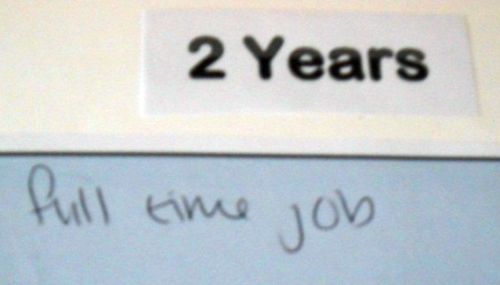

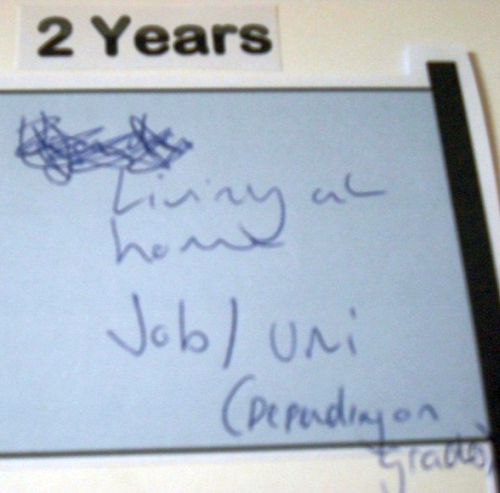
Appendix 4
Student poster data ten years (Source: From the author's own collection)

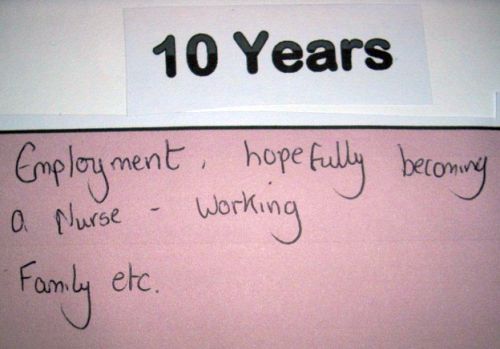
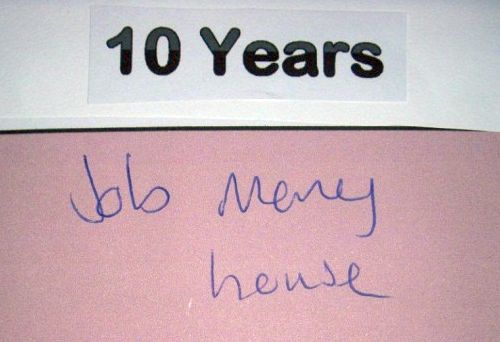


Notes
[1] Zoe Baker has recently completed and achieved a First Class degree in BA (Hons) Education Studies and Sociology. She is beginning a Masters degree in Educational Research in September 2012 at the University of Sheffield, and hopefully moving onto study a PhD upon completion of this.
References
Alley, Stuart and Mat Smith (2004), 'Timeline: Tuition fees', The Guardian, 27 January 2004, http://www.guardian.co.uk/education/2004/jan/27/tuitionfees.students, accessed 8 January 2012
Archer, Louise (2000), Social Class and Access to Higher Education: A Report of findings from the Social Class and Widening Participation to HE, London: University of North London
Archer, Louise and Merryn Hutchings (2000), 'Bettering Yourself? Discourses of risk, cost and benefit in ethnically diverse, young working-class nonparticipants' constructions of higher education', British Journal of Sociology of Education, 21 (4), 555-74
Archer, Louise and Merryn Hutchings (2001), 'Higher than Einstein': Constructions of going to university among working class non-participants, London: University of North London
Archer, Louise, Merryn Hutchings and Alistair Ross (2003), Higher Education and Social Class: Issues of exclusion and inclusion, London: RoutledgeFalmer
Ball, Stephen, Miriam David, Jackie Davies and Diane Reay (2002), ''Classification' and 'Judgement': Social class and the 'Cognitive Structures' of choice of Higher Education', British Journal of Sociology of Education, 23 (1), 51-72
Ball, Stephen, Miriam David and Diane Reay (2005), Degrees of Choice: Class, Race, Gender and Higher Education, Staffordshire: Trentham Books
Barnett, Heather (2009), Inspection under section 5 of the Education Act 2005: Wisewood School and Community Sports College, Rural Lane, Sheffield, S6 4BH, www.ofsted.gov.uk/provider/files/920611/urn/107125.pdf, accessed 21 June 2012
BBC News (2009), UK in Recession as Economy Slides, http://news.bbc.co.uk/1/hi/business/7846266.stm, accessed 27 April 2012
BBC News (2011), At a glance: Universities White Paper, http://www.bbc.co.uk/news/education-13939525, accessed 31 August 2011
Callender, Claire and Jonathan Jackson (2005), 'Does the fear of debt deter students from Higher Education?' Journal of Social Policy, 34 (4), 509-40
Channel 4 News (2011), University White Paper sets out competition plan, http://www.channel4.com/news/government-announces-university-shake-up, accessed 2 December 2011
Christie, Hazel and Moira Munro (2003), 'The Logic of Loans: students' perceptions of the costs and benefits of the student loan', British Journal of Sociology of Education, 24 (5), 621-36
Cousin, Glynis (2009), Researching learning in Higher Education: An introduction to contemporary methods and approaches, Oxford: Routledge
Department for Business, Innovation and Skills (2011), Students at the Heart of the System, http://www.parliament.uk/business/committees/committees-a-z/commons-select/business-innovation-and-skills/
inquiries/the-future-of-higher-education//, accessed 25 March 2012
Department for Business, Innovation and Skills (2011a), Students at the Heart of the System: Consulting on the future of Higher Education, http://discuss.bis.gov.uk/hereform/, accessed 7 December 2011
Department for Business, Innovation and Skills (2011b), Putting students at the heart of higher education, http://bis.gov.uk/news/topstories/2011/Jun/he-white-paper-students-at-the-heart-of-the-system, accessed 12 December 2011
Du-Bois Reymond, Manuela, Harry Guit, Els Peters, Janita Ravesloot and Erwin Van Rooijen (1994), 'Life-course transitions and future orientations of Dutch youth', Young, 2 (3), 3-20
Feinberg, Jonathan (2011), Wordle, http://www.wordle.net/, accessed 25 April 2012
Grix, Jonathan (2010), The foundations of research, Hampshire: Palgrave Macmillan
Higher Education Funding Council (2011), Universities and colleges to provide key information for students, http://www.hefce.ac.uk/media/hefce/content/whatwedo/learningandteaching/informationabouthighereducation/
keyinformationsets/mock_kis.pdf, accessed 7 December 2011
Kay, Helen and Ann Walker (2006), Young Participation in Higher Education in the Parliamentary Constituencies of Nottingham North, Bristol South, Sheffield Brightside and Hodge Hill, Sheffield: Sheffield Hallam University
Klenke, Karin (2008), Qualitative research in the study of leadership, Bingley: Emerald Group Publishing Limited
Lodico, Marguerite G., Dean T. Spaulding and Katherine H. Voegtle (2010), Methods in Educational Research: From theory to practice, San Francisco: John Wiley & Sons
Mitchell, Mark L. and Janina M. Jolley (2010), Research design explained, Belmont: Brooks/Cole Cengage Learning
Molesworth, Mike, Richard Scullion and Elizabeth Nixon (2010), The Marketization of Higher Education: The student as consumer, Oxford: Routledge
Morrison, Andrew (2008), ''I can't do any more education': Class, individualisation and educational decision‐making', Journal of Vocational Education and Training, 60 (4), 349-62
Muir, David (2009), Inspection under section 5 of the Education Act 2005: Myers Grove School, Wood Lane, Sheffield, S6 5HG, www.ofsted.gov.uk/provider/files/939763/urn/107132.pdf, accessed 21 June 2012
NUS.org (2011), Funding our Future: What's another year? http://www.nus.org.uk/en/campaigns/funding-our-future/whats-another-year-/, accessed 20 April 2012
Parliament.co.uk (2012), Young people in the labour market, http://www.parliament.uk/business/publications/research/key-issues-for-the-new-parliament/economic-recovery/young-people-in-the-labour-market/, accessed 24 April 2012
Paton, Graeme (2011), 'Higher Education White Paper: Universities to be ranked on job prospects', The Telegraph, 28 June 2011, http://www.telegraph.co.uk/education/universityeducation/8601718/Higher-Education-White-Paper
-universities-to-be-ranked-on-job-prospects.html, accessed 7 December 2011
Reay, Diane (1998), ''Always knowing' and 'never being sure': familial and institutional habituses and higher education choice', Journal of Education Policy, 13 (4), 519-29
Reay, Diane (2001), 'Choices of Degree or Degrees of Choice? Class,
'Race' and the Higher Education Choice Process', Sociology, 35 (4), 855-74
Scott, Peter (2011), 'Is the white paper's real purpose to cut costs?', The Guardian, 4 July 2011, http://www.guardian.co.uk/education/2011/jul/04/white-paper-broken-promises, accessed 7 July 2011
Seaton, Nigel (2011), 'Higher education white paper signals worrying return to the binary divide', The Guardian, 8 July 2011, http://www.guardian.co.uk/higher-education-network/blog/2011/jul/08/higher-education-white-paper-binary-divide, accessed 5 February 2012
This is Money (2011), Universities to be made better value for money to make up for tuition fees hike, http://www.thisismoney.co.uk/money/news/article-2009038/Universities-set-greater-competition-
transparency-long-awaited-white-paper-revealed.html, accessed 28 June 2011
Vasagar, Jeevan (2011a), 'University reforms: 'Dead-end' courses to be named and shamed', The Guardian, 28 June 2011, http://www.guardian.co.uk/education/2011/jun/28/university-reforms-dead-end-courses-named-shamed, accessed 28 June 2011
Vasagar, Jeevan (2011b), 'University admissions could create two-tier system, committee warns', The Guardian, 10 November 2011, http://www.guardian.co.uk/education/2011/nov/10/university-admission-two-tier-system, accessed 6 December 2011
Vasagar, Jeevan, Jessica Shepherd and Helene Mulholland (2011), 'University reforms: 'dead-end' courses to be named and shamed', The Guardian, 28 June 2011, http://www.guardian.co.uk/education/2011/jun/28/university-reforms-dead-end-courses-named-shamed, accessed 18 April 2012
Vasagar, Jeevan and Rachel Williams (2010), 'University tuition fees hike 'will deter most poorer students' – poll', The Guardian, 18 November 2010, http://www.guardian.co.uk/education/2010/nov/18/ipsos-mori-poll-tuition-fees-cuts, accessed 15 March 2012
To cite this paper please use the following details: Baker, Z. (2012), 'Student and Staff Perceptions of Decision-making in the changing Higher Education Context', Reinvention: a Journal of Undergraduate Research, British Conference of Undergraduate Research 2012 Special Issue, www.warwick.ac.uk/go/reinventionjournal/issues/bcur2012specialissue/baker. Date accessed [insert date]. If you cite this article or use it in any teaching or other related activities please let us know by e-mailing us at Reinventionjournal@warwick.ac.uk.
Spoken Presentation at BCUR